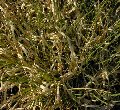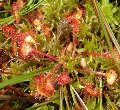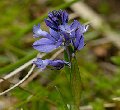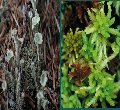Other Plants
Heathlands are relatively poor in diversity of plant species, but they do support a number of plants which are not found elsewhere. Many of these plants rely on the nutrient-poor, acidic soils to reduce competition from other, more common plant species.
 Two species of gorse are common on Hampshire’s/Surrey's heaths. Their spiky foliage and yellow, coconut scented flowers make them unmistakable. Dwarf gorse grows amongst the heathers and is of a similar size. It flowers in mid summer. Common gorse is larger and forms dense bushes which mostly flower in the spring. Both species support large numbers of animals, including many species of spider and nesting Dartford warblers.
Two species of gorse are common on Hampshire’s/Surrey's heaths. Their spiky foliage and yellow, coconut scented flowers make them unmistakable. Dwarf gorse grows amongst the heathers and is of a similar size. It flowers in mid summer. Common gorse is larger and forms dense bushes which mostly flower in the spring. Both species support large numbers of animals, including many species of spider and nesting Dartford warblers. Grasses are an important component of heathland vegetation. Most species find it difficult to grow on heathland soils, but those that are able to survive provide food and shelter for a rich variety of insects.
Grasses are an important component of heathland vegetation. Most species find it difficult to grow on heathland soils, but those that are able to survive provide food and shelter for a rich variety of insects. Insectivorous plants are able to gain nutrients from catching and feeding on insects. They grow on waterlogged soils where nutrient availability from the soil is low. Sundews have sticky secretions on their leaves which trap insects, and slowly curl over before digesting them. Butterwort and bladderwort are other insectivorous plants which live in wet areas of heathland.
Insectivorous plants are able to gain nutrients from catching and feeding on insects. They grow on waterlogged soils where nutrient availability from the soil is low. Sundews have sticky secretions on their leaves which trap insects, and slowly curl over before digesting them. Butterwort and bladderwort are other insectivorous plants which live in wet areas of heathland. A variety of herbaceous plants are found in the wetter areas of a heathland. These are important nectar sources at different times of the year and are often food supplies for specific insects. Common herbaceous plants found on a heath include tormentil, a small yellow four-petalled flower and the tiny milkwort, with two blue petals either side of a white trumpet.
A variety of herbaceous plants are found in the wetter areas of a heathland. These are important nectar sources at different times of the year and are often food supplies for specific insects. Common herbaceous plants found on a heath include tormentil, a small yellow four-petalled flower and the tiny milkwort, with two blue petals either side of a white trumpet. Mosses and lichens are an important component of a heathland. Different species thrive in different conditions. In wet areas Sphagnum Moss (otherwise known as Bog-moss) can create a thick mat on which other plants grow, and In drier areas pale green ‘cup lichens’ grow in patches between heather plants.
Mosses and lichens are an important component of a heathland. Different species thrive in different conditions. In wet areas Sphagnum Moss (otherwise known as Bog-moss) can create a thick mat on which other plants grow, and In drier areas pale green ‘cup lichens’ grow in patches between heather plants.